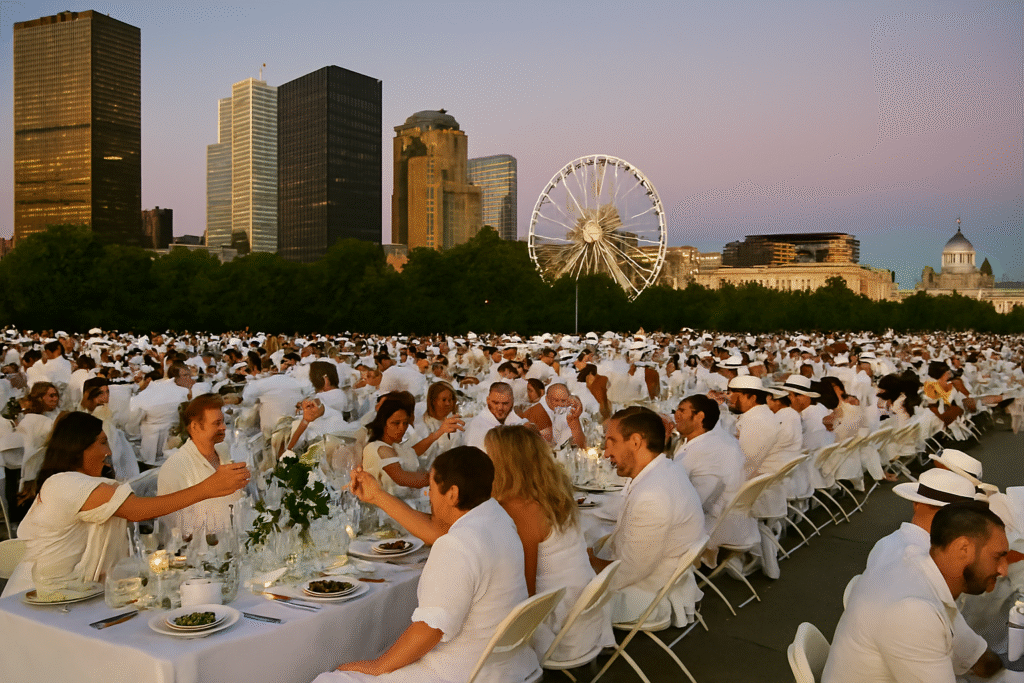Table of Contents
- Introduction
- History of the Global All-White Picnic
- What Happens at the Event
- How to Participate
- Frequently Asked Questions
Introduction
Le Dîner en Blanc is a world-renowned all-white pop-up picnic that transforms cities into elegant dining and cultural experiences. Guests dressed in white gather at secret locations to enjoy gourmet meals, music, and dancing while celebrating community and style. This iconic event encourages social connection and creativity. Whether attending for the first time or as a returning participant, Le Dîner en Blanc offers a unique opportunity to experience a global cultural event.
History of the Global All-White Picnic
The first Le Dîner en Blanc was held in Paris in 1988 by François Pasquier, who invited friends for a white-themed picnic. Today, the event spans over 90 cities worldwide, including New York, Chicago, and Singapore (Wikipedia). Thousands of participants annually enjoy this exclusive cultural gathering, making it one of the most recognized pop-up picnics globally. For more details on the event’s history, visit the official Le Dîner en Blanc website.
What Happens at the Event
At a pop-up picnic, attendees can expect:
- Secret Locations: The venue is revealed shortly before the event.
- Elegant Attire: Guests wear all-white outfits and accessories.
- Gourmet Dining: Participants bring tables, chairs, and meals.
- Entertainment: Music, dancing, and occasional performances.
- Community Spirit: The event fosters connections and shared experiences.
For related experiences, see the guide to global pop-up gatherings.
How to Participate
- Register through the official Le Dîner en Blanc website.
- Receive an Invitation: Priority access is often for returning attendees.
- Prepare: Bring a white table, chairs, and a gourmet meal.
- Arrive: Follow instructions to set up at the secret location.
Frequently Asked Questions
Q: Can I attend without an invitation?
A: Most events are invite-only, but some cities maintain waiting lists (Axios coverage).
Q: What if it rains?
A: The event proceeds rain or shine; bring clear or white rain gear.
Q: Is alcohol allowed?
A: Policies vary by location; some events offer wine or champagne for purchase.
Q: How should I dress?
A: Guests must wear all white, including accessories and shoes.
Introduction
This comprehensive Watch Buying Guide answers the most common questions about timepieces.
Whether you’re purchasing your first watch or adding to your collection, these expert insights help you make informed decisions.
From understanding movement types to choosing the right size for your wrist, you’ll find everything needed before making a purchase.
What Types of Watches Should You Consider? – Watch Buying Guide Insights
Understanding the five main categories helps narrow your options:
- Mechanical watches – Use springs and gears. No battery needed.
- Quartz watches – Battery-powered; most accurate.
- Automatic watches – Wind themselves from wrist movement.
- Digital watches – Display time numerically on a screen.
- Smartwatches – Connect to your phone and track fitness data.
Accuracy Expectations – Watch Buying Guide Tips
- Quartz watches – Lose about 15 seconds per month.
- Mechanical watches – Lose 20–40 seconds per day.
- Atomic watches – Lose 1 second every 100 million years.
- Your phone’s clock stays perfectly accurate.
Water Resistance Considerations
Water resistance ratings affect usage scenarios:
- 30m – Handles rain and handwashing
- 50m – Safe for swimming
- 100m – Suitable for snorkeling
- 200m+ – Scuba diving
Replace gaskets every 2–3 years to maintain resistance.
Maintenance Schedule – Watch Buying Guide Advice
- Quartz watches – Battery replacement every 1–3 years.
- Mechanical watches – Full service every 3–5 years.
- Service costs: $200–800 depending on the brand.
Watch for stopping, running fast/slow, or condensation under the crystal.
Pricing Strategy
- Budget watches – Plastic cases, basic movements
- Mid-range watches – Steel cases, reliable mechanisms
- Luxury watches – Precious metals, hand-finished details
Remember: craftsmanship, materials, and brand prestige drive prices.
Sizing Advice
- 6–7 inch wrists – 38–42mm
- 7–8 inch wrists – 40–44mm
- 8+ inch wrists – 42–46mm
Ensure lugs don’t overhang wrist edges.
Complications to Prioritize
- Date display – Useful daily
- GMT hand – Second time zone
- Chronograph – Stopwatch
- Moon phase – Decorative
- Annual calendar – Adjusts month lengths
More complications = more things that can break.
Maintenance Tips
- Clean with a soft cloth
- Avoid extreme temperatures & magnets
- Wind manual watches daily
- Use watch winders for automatics
- Don’t adjust date between 9 PM–3 AM
Investment Potential
- Most watches lose value after purchase
- Only select Rolex, Patek Philippe, Audemars Piguet models appreciate
- Vintage watches from 1960s–70s show strong growth
- Buy watches you enjoy wearing, not solely for investment
Essential Tools
- Spring bar tool
- Case back opener
- Soft polishing cloth
- Watch cushion
- Demagnetizer
Where to Purchase
- Online – Better selection, often cheaper
- Physical stores – Try before buying
- Authorized dealers – Full warranties
- Grey market – Discounts, limited warranty
- Forums/eBay – Vintage pieces, verify authenticity
Learn More:



